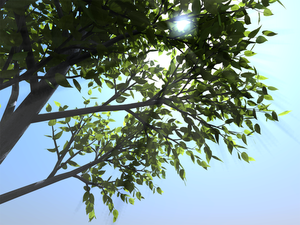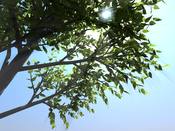Information
- Publication Type: PhD-Thesis
- Workgroup(s)/Project(s):
- Date: February 2009
- Date (Start): May 2005
- Date (End): March 2009
- TU Wien Library:
- Second Supervisor: Oliver Deussen
- Rigorosum: 6. March 2009
- First Supervisor: Michael Wimmer
- Keywords: Animation, Real-time Rendering, Vegetation
Abstract
Vegetation rendering and animation in real-time applications still pose a significant problem due to the inherent complexity of plants. Both the high geometric complexity and intricate light transport require specialized techniques to achieve high-quality rendering of vegetation in real time. This thesis presents new algorithms that address various areas of both vegetation rendering and animation.For grass rendering, an efficient algorithm to display dense and short grass is introduced. In contrast to previous methods, the new approach is based on ray tracing to avoid the massive overdraw of billboard or explicit geometry representation techniques, achieving independence of the complexity of the grass without losing the visual characteristics of grass such as parallax and occlusion effects as the viewpoint moves.
Also, a method to efficiently render leaves is introduced. Leaves exhibit a complex light transport behavior due to subsurface scattering and special attention is given to the translucency of leaves, an integral part of leaf shading. The light transport through a leaf is precomputed and can be easily evaluated at runtime, making it possible to shade a massive amount of leaves while including the effects that occur due to the leaf structure such as varying albedo and thickness variations or self shadowing.
To animate a tree, a novel deformation method based on a structural mechanics model that incorporates the important physical properties of branches is introduced. This model does not require the branches to be segmented by joints as other methods, achieving smooth and accurate bending, and can be executed fully on a GPU. To drive this deformation, an optimized spectral approach that also incorporates the physical properties of branches is used. This allows animating a highly detailed tree with thousands of branches and ten thousands of leaves efficiently.
Additionally, a method to use dynamic skylight models in spherical harmonics precomputed radiance transfer techniques is introduced, allowing to change the skylight parameters in real time at no considerable cost and memory footprint.
Additional Files and Images
Additional images and videos
Additional files
 Thesis:
Real-time Rendering and Animation of Vegetation
Thesis:
Real-time Rendering and Animation of Vegetation
Weblinks
No further information available.BibTeX
@phdthesis{Habel_2009_PhD,
title = "Real-time Rendering and Animation of Vegetation",
author = "Ralf Habel",
year = "2009",
abstract = "Vegetation rendering and animation in real-time applications
still pose a significant problem due to the inherent
complexity of plants. Both the high geometric complexity and
intricate light transport require specialized techniques to
achieve high-quality rendering of vegetation in real time.
This thesis presents new algorithms that address various
areas of both vegetation rendering and animation. For grass
rendering, an efficient algorithm to display dense and short
grass is introduced. In contrast to previous methods, the
new approach is based on ray tracing to avoid the massive
overdraw of billboard or explicit geometry representation
techniques, achieving independence of the complexity of the
grass without losing the visual characteristics of grass
such as parallax and occlusion effects as the viewpoint
moves. Also, a method to efficiently render leaves is
introduced. Leaves exhibit a complex light transport
behavior due to subsurface scattering and special attention
is given to the translucency of leaves, an integral part of
leaf shading. The light transport through a leaf is
precomputed and can be easily evaluated at runtime, making
it possible to shade a massive amount of leaves while
including the effects that occur due to the leaf structure
such as varying albedo and thickness variations or self
shadowing. To animate a tree, a novel deformation method
based on a structural mechanics model that incorporates the
important physical properties of branches is introduced.
This model does not require the branches to be segmented by
joints as other methods, achieving smooth and accurate
bending, and can be executed fully on a GPU. To drive this
deformation, an optimized spectral approach that also
incorporates the physical properties of branches is used.
This allows animating a highly detailed tree with thousands
of branches and ten thousands of leaves efficiently.
Additionally, a method to use dynamic skylight models in
spherical harmonics precomputed radiance transfer techniques
is introduced, allowing to change the skylight parameters in
real time at no considerable cost and memory footprint.",
month = feb,
address = "Favoritenstrasse 9-11/E193-02, A-1040 Vienna, Austria",
school = "Institute of Computer Graphics and Algorithms, Vienna
University of Technology ",
keywords = "Animation, Real-time Rendering, Vegetation",
URL = "https://www.cg.tuwien.ac.at/research/publications/2009/Habel_2009_PhD/",
}


 Thesis
Thesis